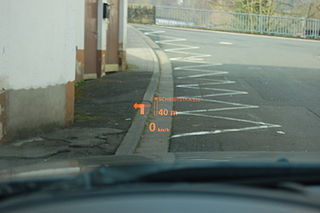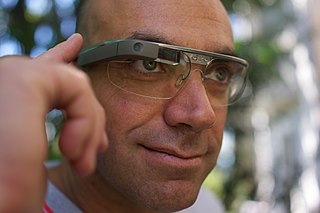 W
WMixed reality (MR) is the merging of real and virtual worlds to produce new environments and visualizations, where physical and digital objects co-exist and interact in real time. Mixed reality does not exclusively take place in either the physical or virtual world, but is a hybrid of reality and virtual reality. There are many practical applications of mixed reality, including entertainment, military training, and remote working. There are also different display technologies used to facilitate the interaction between users and mixed reality applications.
 W
WARToolKit is an open-source computer tracking library for creation of strong augmented reality applications that overlay virtual imagery on the real world. Currently, it is maintained as an open-source project hosted on GitHub. ARToolKit is a very widely used AR tracking library with over 160,000 downloads on its last public release in 2004.
 W
WAn automotive head-up display or automotive heads-up display —also known as a auto-HUD— is any transparent display that presents data in the automobile without requiring users to look away from their usual viewpoints. The origin of the name stems from a pilot being able to view information with the head positioned "up" and looking forward, instead of angled down looking at lower instruments. At this time, there are two different approaches to OEM HUDs in automobiles. The first is to treat the back of the windshield in such a way that an image projected onto it will reflect to the driver. The second is to have a small combiner that is separate from the windshield. Combiners can be retracted.
 W
WcastAR was a Palo Alto-based technology startup company founded in March 2013 by Jeri Ellsworth and Rick Johnson. Its first product was to be the castAR, a pair of augmented reality and virtual reality glasses. castAR was a founding member of the nonprofit Immersive Technology Alliance.
 W
WA Cave Automatic Virtual Environment is an immersive virtual reality environment where projectors are directed to between three and six of the walls of a room-sized cube. The name is also a reference to the allegory of the Cave in Plato's Republic in which a philosopher contemplates perception, reality, and illusion.
 W
WDaemon and Freedom™ comprise a two-part novel by the author Daniel Suarez about a distributed, persistent computer application, the Daemon, that begins to change the real world after the original programmer's death.Daemon (2006) ISBN 978-0-9786271-0-2 paperback; (2009) hardcover re-release ISBN 978-0-525-95111-7 Freedom™ (2010) ISBN 978-0-525-95157-5
 W
WThe EyeToy is a color webcam for use with the PlayStation 2. Supported games use computer vision and gesture recognition to process images taken by the EyeToy. This allows players to interact with the games using motion, color detection, and also sound, through its built-in microphone. It was released in October 2003.
 W
WFreedom™, the sequel to Daemon, is the second of a two-part novel, by the author Daniel Suarez, about a distributed, persistent computer application, known as The Daemon, that begins to change the real world after the original programmer's death.
 W
WFreeTrack is a general-purpose optical motion tracking application for Microsoft Windows, released under the GNU General Public License, that can be used with common inexpensive cameras. Its primary focus is head tracking with uses in virtual reality, simulation, video games, 3D modeling, computer aided design and general hands-free computing to improve computer accessibility. Tracking can be made sensitive enough that only small head movements are required so that the user's eyes never leave the screen.
 W
WA head-mounted display (HMD) is a display device, worn on the head or as part of a helmet, that has a small display optic in front of one or each eye. An HMD has many uses including gaming, aviation, engineering, and medicine. Virtual reality headsets are HMDs combined with IMUs. There is also an optical head-mounted display (OHMD), which is a wearable display that can reflect projected images and allows a user to see through it.
 W
WA head-up display or heads-up display, also known as a HUD, is any transparent display that presents data without requiring users to look away from their usual viewpoints. The origin of the name stems from a pilot being able to view information with the head positioned "up" and looking forward, instead of angled down looking at lower instruments. A HUD also has the advantage that the pilot's eyes do not need to refocus to view the outside after looking at the optically nearer instruments.
 W
WMicrosoft HoloLens 2 is a pair of mixed reality smartglasses developed and manufactured by Microsoft. It is the successor to the pioneering Microsoft HoloLens. On February 24, 2019 the HoloLens 2 enterprise edition debuted as the first variant of the device, followed by a developer edition that was announced on May 2, 2019. It was subsequently released in limited numbers on November 7, 2019.
 W
WThe term immersive technology refers to the technology that is used to create a virtual world for its users. Immersive technology uses a simulated world to create the feel of being in a physical world. This surrounding sensory feeling felt by the user gives the user a sense of immersion in real life setting. The blend of virtual reality and augmented reality is called mixed reality.
 W
WInteractive art is a form of art that involves the spectator in a way that allows the art to achieve its purpose. Some interactive art installations achieve this by letting the observer or visitor "walk" in, on, and around them; some others ask the artist or the spectators to become part of the artwork.
 W
WLumus is an Israeli-based Augmented Reality company headquartered in Ness Ziona, Israel. Founded in 2000, Lumus has developed technology for see-through wearable displays, via its patented Light-guide Optical Element (LOE) platform to market producers of smart glasses and augmented reality eyewear. Lumus' technology enables a small natural looking form factor, wide field of view and true see-through performance.
 W
WMicrosoft HoloLens, known under development as Project Baraboo, are a pair of mixed reality smartglasses developed and manufactured by Microsoft. HoloLens was the first head-mounted display running the Windows Mixed Reality platform under the Windows 10 computer operating system. The tracking technology used in HoloLens can trace its lineage to Kinect, an add-on for Microsoft's Xbox game console that was introduced in 2010.
 W
WOculus is a brand of Facebook Technologies, LLC, a subsidiary of Facebook Inc. The division produces virtual reality headsets, including the Oculus Rift and Oculus Quest lines.
 W
WAn optical head-mounted display (OHMD) is a wearable device that has the capability of reflecting projected images as well as allowing the user to see through it, similar to augmented reality technology. OHMD technology has existed since 1997 in various forms, but despite a number of attempts from industry, has yet to be commercialised.
 W
WThe Samsung Gear VR is a virtual reality headset developed by Samsung Electronics, in collaboration with Oculus VR, and manufactured by Samsung. The headset was released on November 27, 2015.
 W
WSmartglasses or smart glasses are wearable computer glasses that add information alongside or to what the wearer sees. Alternatively, smartglasses are sometimes defined as wearable computer glasses that are able to change their optical properties at runtime. Smart sunglasses which are programmed to change tint by electronic means are an example of the latter type of smartglasses.
 W
WTrackIR is an optical motion tracking game controller for Microsoft Windows created by NaturalPoint Inc.. TrackIR tracks head motions with up to six degrees of freedom (6DOF) in later models, allowing handsfree view control for improved game immersiveness and situational awareness. Head position and orientation are measured by a purpose-built video camera, mounted on top of the user's monitor, which observes invisible infrared (IR) light reflected or emitted by markers on a rigid model worn by the user. TrackIR software is used to access and control the camera, as well as adjust tracking and manage game profiles. The ratio of actual head movement to virtual head movement can be changed, allowing the virtual head to turn 180 degrees whilst the user still looks at the monitor.
 W
WA virtual retinal display (VRD), also known as a retinal scan display (RSD) or retinal projector (RP), is a display technology that draws a raster display directly onto the retina of the eye. The user sees what appears to be a conventional display floating in space in front of them.
 W
WWindows Mixed Reality is a mixed reality platform introduced as part of the Windows 10 operating system, which provides augmented reality and mixed reality experiences with compatible head-mounted displays.
 W
WXi was the world's first console-based and virtual world-based alternate reality game. It was a one-time-only play, unfolding in real time, and only available on the PlayStation 3 through the social gaming network, PlayStation Home. The game was an adventure to help find "Jess" and the meaning of Xi by collecting fragments and butterflies found in a series of secret areas in Home that changed frequently. The game also challenged the users to search for clues in the real world. The game was created by nDreams who released several spaces for Xi. The game was promoted through a teaser campaign of clues and hints during the month prior to its release on March 23, 2009. The clues were hidden in the Menu Pad and videos in the central meeting point.